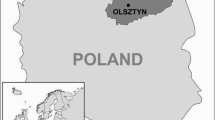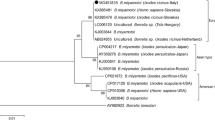Abstract
In 2014, a new tick species, Ixodes inopinatus, was described, which is closely related to Ixodes ricinus. So far, I. inopinatus has been found in Tunisia, Morocco, Spain, Portugal, Romania, Austria, and southern Germany. No data is yet available regarding occurrence of I. inopinatus in northern Germany and the potential role of I. inopinatus as a vector for tick-borne pathogens. Therefore, 3845 DNA samples from Ixodes ticks collected for prevalence studies on Borrelia spp., Rickettsia spp., and Anaplasma phagocytophilum during the years 2010–2015 in the northern German cities of Hamburg and Hanover were differentiated into I. ricinus or I. inopinatus by sequencing a part of the 16S rRNA gene. In total, 4% (137/3845) of the sequenced ticks were assigned to the species I. inopinatus and 96% (3708/3845) to I. ricinus. The prevalence of Borrelia spp., Rickettsia spp., and A. phagocytophilum DNA in I. inopinatus was 34% (46/137), 46% (63/137), and 3% (4/137), respectively, whereas the prevalence of these bacteria in I. ricinus was 25% (919/3708), 47% (1729/3708), and 4% (135/3708), respectively. Compared with I. ricinus, significantly more I. inopinatus ticks tested positive for Borrelia. To the best of our knowledge, this is the first report of I. inopinatus in northern Germany. Detection of the DNA of Borrelia spp., Rickettsia spp., and A. phagocytophilum in questing I. inopinatus indicates a potential role of this tick species as a vector of these pathogens, which needs to be confirmed by transmission experiments.

Similar content being viewed by others
References
Blazejak K, Janecek E, Strube C (2017) A 10-year surveillance of Rickettsiales (Rickettsia spp. and Anaplasma phagocytophilum) in the city of Hanover, Germany, reveals Rickettsia spp. as emerging pathogens in ticks. Parasit Vectors 10:588. https://doi.org/10.1186/s13071-017-2537-2
Blazejak K, Raulf MK, Janecek E, Jordan D, Fingerle V, Strube C (2018) Shifts in Borrelia burgdorferi (s.l.) geno-species infections in Ixodes ricinus over a 10-year surveillance period in the city of Hanover (Germany) and Borrelia miyamotoi-specific Reverse Line Blot detection. Parasit Vectors 11:304. https://doi.org/10.1186/s13071-018-2882-9
Chitimia-Dobler L, Rieß R, Kahl O, Wölfel S, Dobler G, Nava S, Estrada-Peña A (2018) Ixodes inopinatus − occurring also outside the Mediterranean region. Ticks Tick Borne Dis 9:196–200
Core Team R (2018) R: A language and environment for statistical computing. R Foundation for Statistical Computing, Vienna
Dobler G, Wölfel R (2009) Typhus and other rickettsioses: emerging infections in Germany. Dtsch Arztebl Int 106:348
Dumler JS et al (2005) Human granulocytic anaplasmosis and Anaplasma phagocytophilum. Emerg Infect Dis 11:1828
Estrada-Peña A, Nava S, Petney T (2014) Description of all the stages of Ixodes inopinatus n. sp. (Acari: Ixodidae). Ticks Tick Borne Dis 5:734–743. https://doi.org/10.1016/j.ttbdis.2014.05.003
Fingerle V, Munderloh U, Liegl G, Wilske B (1999) Coexistence of ehrlichiae of the phagocytophila group with Borrelia burgdorferi in Ixodes ricinus from Southern Germany. Med Microbiol Immunol 188:145–149
Franke J, Fritzsch J, Tomaso H, Straube E, Dorn W, Hildebrandt A (2010) Coexistence of pathogens in host-seeking and feeding ticks within a single natural habitat in Central Germany. Appl Environ Microbiol 76:6829–6836. https://doi.org/10.1128/AEM.01630-10
Gern L, Humair PF (2002) Ecology of Borrelia burgdorferi sensu lato in Europe. In: Gray J, Kahl O, Lane RS, Stanek G (eds) Lyme borreliosis: biology, epidemiology, and control. CABI Publishing, Oxon, pp 149–174
Gugliotta JL, Goethert HK, Berardi VP, Telford SR 3rd (2013) Meningoencephalitis from Borrelia miyamotoi in an immunocompromised patient. N Engl J Med 368:240–245. https://doi.org/10.1056/NEJMoa1209039
Henningsson AJ, Hvidsten D, Kristiansen BE, Matussek A, Stuen S, Jenkins A (2015) Detection of Anaplasma phagocytophilum in Ixodes ricinus ticks from Norway using a realtime PCR assay targeting the Anaplasma citrate synthase gene gltA. BMC Microbiol 15:153. https://doi.org/10.1186/s12866-015-0486-5
Hovius JWR et al (2013) A case of meningoencephalitis by the relapsing fever spirochaete Borrelia miyamotoi in Europe. Lancet 382. https://doi.org/10.1016/s0140-6736(13)61644-x
Humair P-F, Gern L (2000) The wild hidden face of Lyme borreliosis in Europe. Microbes Infect 2:915–922
Kovalev SY, Golovljova IV, Mukhacheva TA (2016) Natural hybridization between Ixodes ricinus and Ixodes persulcatus ticks evidenced by molecular genetics methods. Ticks Tick Borne Dis 7:113–118. https://doi.org/10.1016/j.ttbdis.2015.09.005
Krause PJ, Schwab J, Narasimhan S, Brancato J, Xu G, Rich SM (2016) Hard tick relapsing fever due to Borrelia miyamotoi in a Child. Pediatr Infect Dis J 35:1352–1354. https://doi.org/10.1097/INF.0000000000001330
Kurtenbach K, Hanincova K, Tsao JI, Margos G, Fish D, Ogden NH (2006) Fundamental processes in the evolutionary ecology of Lyme borreliosis. Nat Rev Microbiol 4:660–669. https://doi.org/10.1038/nrmicro1475
Mangold A, Bargues M, Mas-Coma S (1997) 18S rRNA gene sequences and phylogenetic relationships of European hard-tick species (Acari: Ixodidae). Parasitol Res 84:31–37
Mangold A, Bargues M, Mas-Coma S (1998) Mitochondrial 16S rDNA sequences and phylogenetic relationships of species of Rhipicephalus and other tick genera among Metastriata (Acari: Ixodidae). Parasitol Res 84:478–484
May K, Strube C (2014) Prevalence of Rickettsiales (Anaplasma phagocytophilum and Rickettsia spp.) in hard ticks (Ixodes ricinus) in the city of Hamburg, Germany. Parasitol Res 113:2169–2175. https://doi.org/10.1007/s00436-014-3869-x
May K, Jordan D, Fingerle V, Strube C (2015) Borrelia burgdorferi sensu lato and co-infections with Anaplasma phagocytophilum and Rickettsia spp. in Ixodes ricinus in Hamburg, Germany. Med Vet Entomol 29:425–429. https://doi.org/10.1111/mve.12125
Petney TN, Moser E, Littwin N, Pfäffle M, Muders SV, Taraschewski H (2015) Additions to the “Annotated Checklist of the Ticks of Germany”: Ixodes acuminatus and Ixodes inopinatus. Syst Appl Acarol 20. https://doi.org/10.11158/saa.20.2.9
Randolph S, Green R, Hoodless A, Peacey M (2002) An empirical quantitative framework for the seasonal population dynamics of the tick Ixodes ricinus. Int J Parasitol 32:979–989
Schicht S, Schnieder T, Strube C (2012) Rickettsia spp. and coinfections with other pathogenic microorganisms in hard ticks from northern Germany. J Med Entomol 49:766–771
Schorn S, Pfister K, Reulen H, Mahling M, Manitz J, Thiel C, Silaghi C (2011) Prevalence of Anaplasma phagocytophilum in Ixodes ricinus in Bavarian public parks, Germany. Ticks Tick Borne Dis 2:196–203. https://doi.org/10.1016/j.ttbdis.2011.09.009
Silaghi C, Gilles J, Höhle M, Fingerle V, Just FT, Pfister K (2008) Anaplasma phagocytophilum infection in Ixodes ricinus, Bavaria, Germany. Emerg Infect Dis 14:972
Soleng A, Edgar KS, Paulsen KM, Pedersen BN, Okbaldet YB, Skjetne IEB, Gurung D, Vikse R, Andreassen ÅK (2018) Distribution of Ixodes ricinus ticks and prevalence of tick-borne encephalitis virus among questing ticks in the Arctic Circle region of northern Norway. Ticks Tick Borne Dis 9:97–103
Tappe J, Strube C (2013) Anaplasma phagocytophilum and Rickettsia spp. infections in hard ticks (Ixodes ricinus) in the city of Hanover (Germany): revisited. Ticks Tick Borne Dis 4:432–438. https://doi.org/10.1016/j.ttbdis.2013.04.009
Tappe J, Strube C (2016) Corrigendum to “Anaplasma phagocytophilum and Rickettsia spp. infections in hard ticks (Ixodes ricinus) in the city of Hanover (Germany): Revisited” [Ticks Tick Borne Dis. 4 (2013) 432-438]. Ticks Tick Borne Dis 7:1059–1060. https://doi.org/10.1016/j.ttbdis.2016.03.004
Tappe J, Jordan D, Janecek E, Fingerle V, Strube C (2014) Revisited: Borrelia burgdorferi sensu lato infections in hard ticks (Ixodes ricinus) in the city of Hanover (Germany). Parasit Vectors 7:441
Tappe J, Jordan D, Janecek E, Fingerle V, Strube C (2016) Erratum to: Revisited: Borrelia burgdorferi sensu lato infections in hard ticks (Ixodes ricinus) in the city of Hanover (Germany). Parasit Vectors 9:249. https://doi.org/10.1186/s13071-016-1516-3
Venczel R, Knoke L, Pavlovic M, Dzaferovic E, Vaculova T, Silaghi C, Overzier E, Konrad R, Kolenčík S, Derdakova M, Sing A, Schaub GA, Margos G, Fingerle V (2016) A novel duplex real-time PCR permits simultaneous detection and differentiation of Borrelia miyamotoi and Borrelia burgdorferi sensu lato. Infection 44:47–55. https://doi.org/10.1007/s15010-015-0820-8
Funding
The study was supported by funding from Bayer Vital GmbH and Bayer Animal Health GmbH.
Author information
Authors and Affiliations
Corresponding author
Ethics declarations
Disclaimer
Study data collection and interpretation is completely independent from the company’s opinion.
Conflict of interest
SP is an employee of Bayer Vital GmbH, BS is an employee of Bayer Animal Health GmbH. The authors declare that there is no conflict with commercial interests.
Additional information
Section Editor: Neil Bruce Chilton
Publisher’s note
Springer Nature remains neutral with regard to jurisdictional claims in published maps and institutional affiliations.
Electronic supplementary material
ESM 1
(DOCX 40 kb)
Rights and permissions
About this article
Cite this article
Hauck, D., Springer, A., Pachnicke, S. et al. Ixodes inopinatus in northern Germany: occurrence and potential vector role for Borrelia spp., Rickettsia spp., and Anaplasma phagocytophilum in comparison with Ixodes ricinus. Parasitol Res 118, 3205–3216 (2019). https://doi.org/10.1007/s00436-019-06506-4
Received:
Accepted:
Published:
Issue Date:
DOI: https://doi.org/10.1007/s00436-019-06506-4




